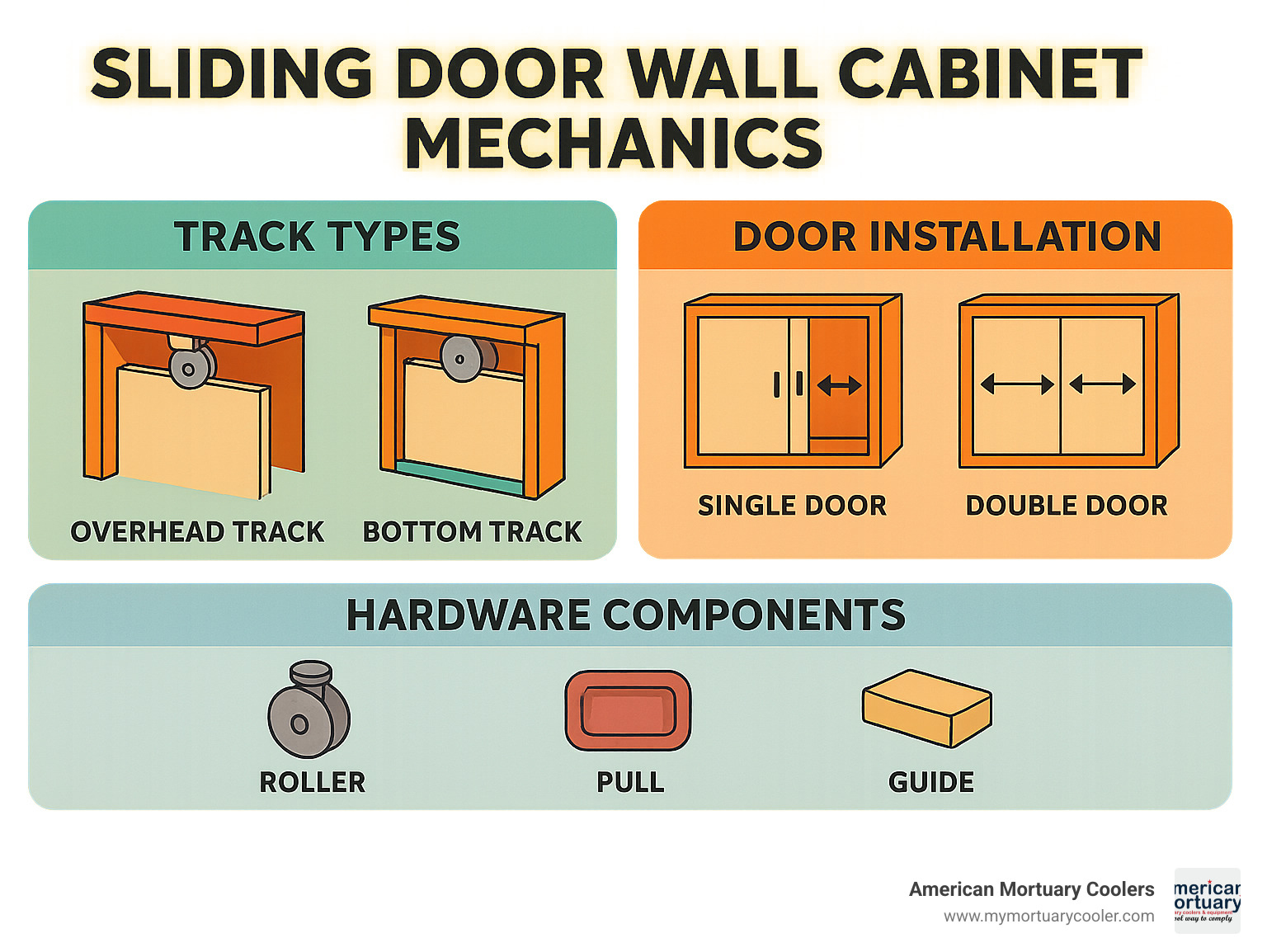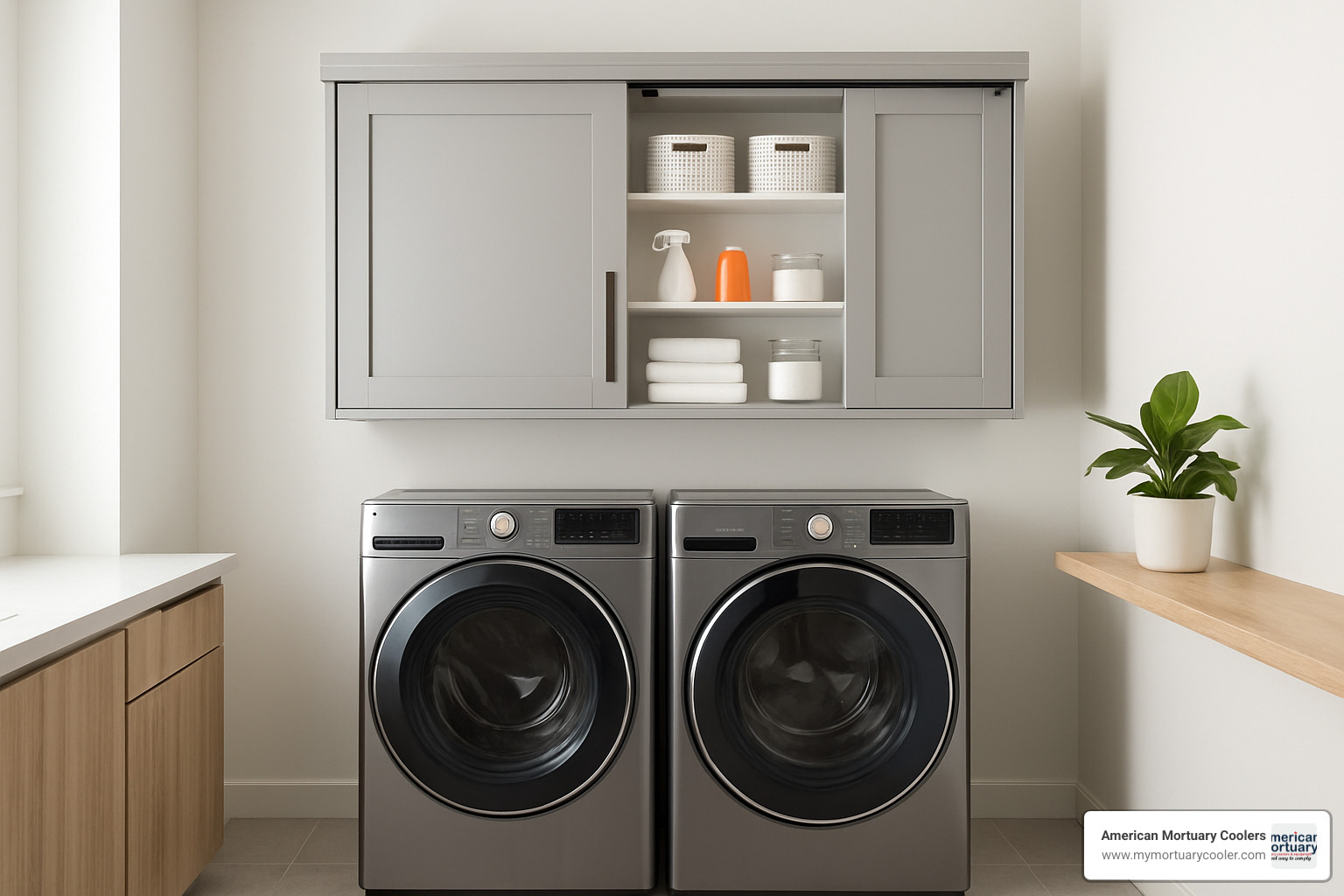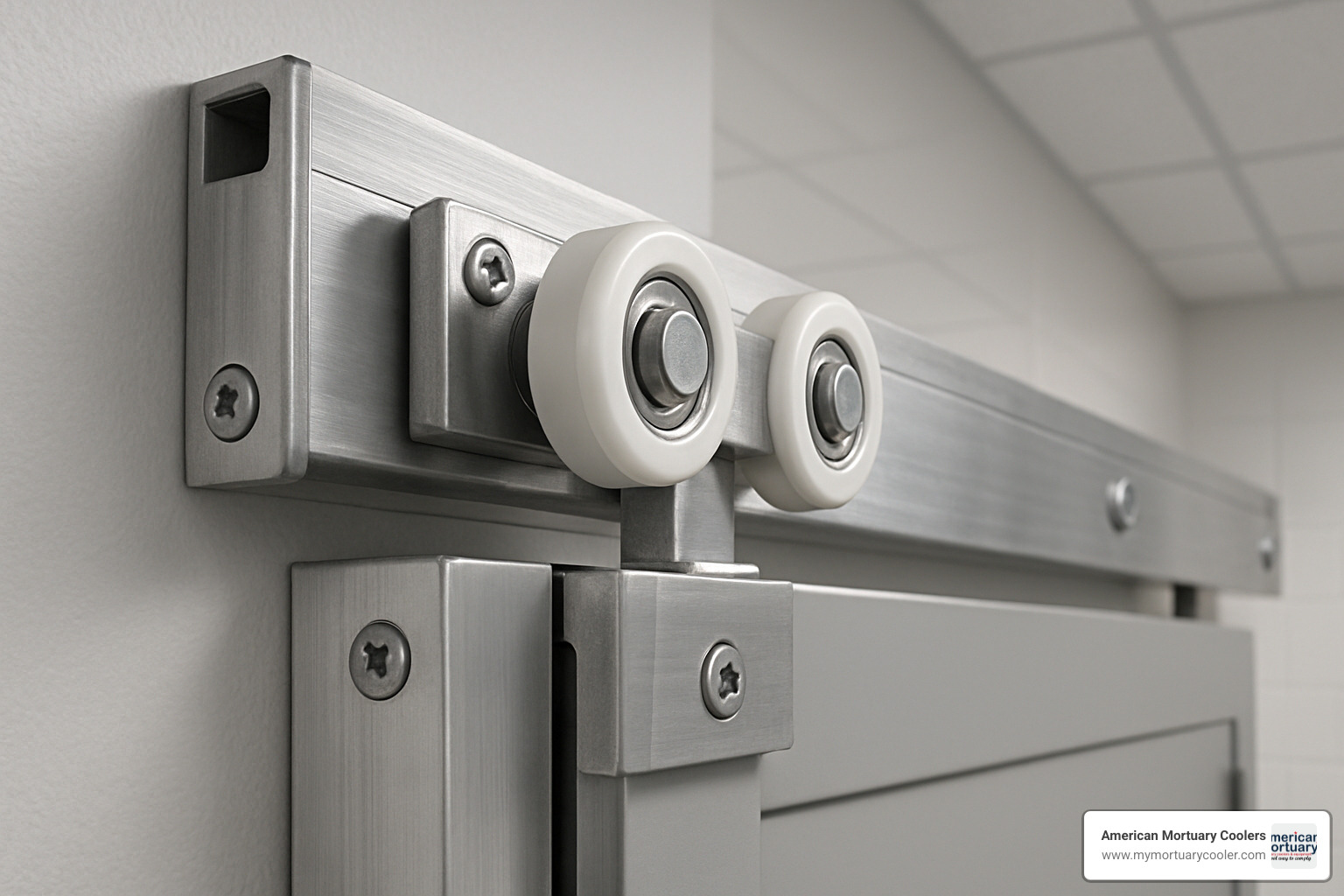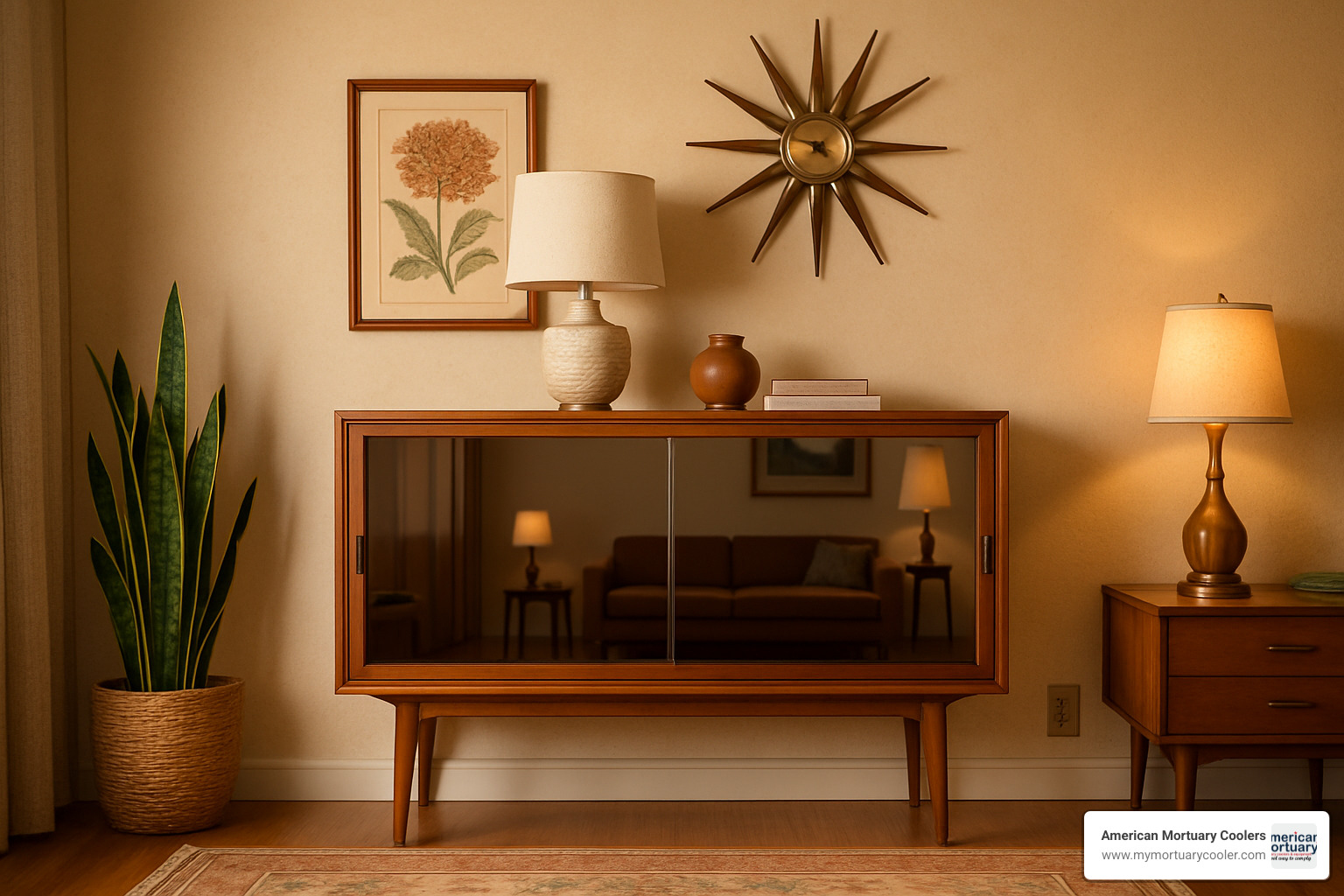The Ultimate Space-Saving Solution for Your Storage Needs
If you're looking for a sliding door wall cabinet, here's what you need to know:
- Definition: A wall-mounted storage unit with doors that slide horizontally on tracks rather than swinging outward
- Key Benefits: Saves space in narrow areas, provides substantial storage without door clearance issues
- Typical Dimensions: Standard units measure around 63" wide × 17¾" deep × 47¼" high
- Weight Capacity: Can support up to 66 lbs per shelf
- Common Applications: Kitchens, offices, laboratories, mortuary prep rooms, and laundry areas
Sliding door wall cabinets represent an neat solution to one of the most common challenges in space planning: how to maximize storage without sacrificing accessibility. Unlike traditional hinged cabinets that require clearance for door swing, sliding door mechanisms operate within the cabinet's footprint, making them ideal for narrow walkways, tight corners, and busy traffic areas.
Many homeowners and facility managers are turning to these space-efficient units not just for their practical benefits, but also for their clean, contemporary aesthetic. The smooth gliding action of well-designed sliding doors adds a touch of sophistication to any space while concealing contents from view.
I'm with American Mortuary Coolers, a national-level supplier specializing in high-performance storage solutions including sliding door wall cabinets designed for demanding professional environments like funeral homes and medical facilities. While competitors like Mopec, Mortech Manufacturing, Affordable Funeral Supply, Thermo Fisher Scientific (Pathology division), LEEC, and Frigid Fluid Company offer similar products, our experience with commercial-grade cabinetry has given us unique insights into the durability and customization options available for these versatile storage solutions.

Key sliding door wall cabinet vocabulary:
What Is a Sliding Door Wall Cabinet?
Ever walked into a kitchen and noticed cabinets with doors that glide sideways instead of swinging out at you? That's a sliding door wall cabinet in action! These space-smart storage solutions use doors that slide horizontally along tracks, rather than swinging outward like traditional cabinets. You'll typically find them mounted on walls, though some free-standing versions come with finished backs for flexibility in placement.
| Feature | Sliding Door Cabinet | Hinged Door Cabinet |
|---|---|---|
| Space Required | Minimal clearance needed | Requires swing radius |
| Access | Partial access (one section at a time) | Full access when open |
| Visibility | Can see only half of contents at once | Can view all contents at once |
| Weight Capacity | Up to 66 lbs per shelf | Often higher weight tolerance |
| Installation Complexity | Moderate (track alignment critical) | Simple (standard hinges) |
| Durability Standards | EN 14073, EN 14074, ANSI/BIFMA X5.9, ISO-7170 | Same industry standards |
| Best Applications | Narrow spaces, walkways, room dividers | Spaces with ample clearance |
When shopping for sliding door wall cabinets, you'll encounter two main types: bypass and pocket doors. Bypass doors slide on parallel tracks that allow the doors to overlap each other (think of your typical closet doors). Pocket doors, on the other hand, neatly disappear into a hidden compartment within the cabinet or wall structure—pretty neat for a completely unobstructed view when open!
Sliding Door Wall Cabinet vs. Traditional Hinged Cabinet
The biggest win for a sliding door wall cabinet is definitely in the space-saving department. If you've ever bumped into an open cabinet door in a narrow hallway or kitchen, you'll appreciate this benefit immediately. These cabinets can save up to 10 square feet of usable floor space in some setups—that's significant in tight quarters!
They also tend to have a slimmer profile since they don't need extra depth for hinges and door swing mechanics. This makes them perfect for shallow spaces where traditional cabinets might stick out too far.
As one homeowner wisely noted in a Houzz discussion about kitchen cabinets with sliding doors, "I have several spots in my kitchen where cabinet doors will open into an aisle way." If this sounds familiar, sliding doors might be your perfect solution too.
While brands like Kraftmaid, Merillat, and Diamond offer excellent traditional cabinets, companies specializing in sliding systems like Hafele and Accuride have revolutionized the sliding door hardware market.
Core Components of a Sliding Door Wall Cabinet
A quality sliding door wall cabinet consists of four essential parts working together:
- Cabinet case: The box structure that holds everything together, typically crafted from particleboard with melamine foil and plastic edging for durability
- Sliding doors: Usually made from the same material as the case, though glass, mirrored, or mixed-material doors are popular options
- Track system: Upper and lower tracks that guide the doors smoothly along their path
- Hardware kit: Includes rollers, guides, handles, and sometimes locks for complete functionality
Most cabinets also include adjustable shelving inside, letting you customize the interior organization based on what you're storing—whether that's kitchen supplies, office materials, or specialized equipment for professional environments.
Pros, Cons, and Smart Uses for Sliding Door Wall Cabinets

Let's talk about what makes sliding door wall cabinets such a smart choice for many spaces—and where you might want to think twice before installing them.
Where Sliding Door Wall Cabinets Shine
When space is at a premium, sliding door wall cabinets truly come into their own. I've seen countless kitchens transformed by these space-saving wonders, where traditional swinging doors would have made the space feel cramped and awkward. Instead, the smooth gliding action keeps walkways clear while still providing all the storage you need.
Office environments benefit tremendously from these cabinets too. In smaller workspaces where every square foot counts, the ability to access storage without needing clearance for swinging doors can make the difference between a functional workspace and a cluttered one.
Healthcare settings and laboratories have acceptd sliding door wall cabinets for their efficiency and cleanliness. The tracks can be designed with minimal crevices where dust might collect, making them easier to maintain in sterile environments. Many clients who run mortuary prep rooms appreciate how these cabinets allow for smooth workflow in spaces where staff need to move quickly and efficiently.
One of my favorite applications is using these cabinets as room dividers. Since many models come with finished backs, they can serve double-duty by creating separation between spaces while offering storage from both sides.
The adjustable shelving is another major plus, supporting up to 66 pounds per shelf. This versatility means your cabinet can hold anything from lightweight linens to heavy equipment. And for those concerned about security, many models include combination locks with user-defined codes—perfect for sensitive items in commercial or healthcare settings.
Potential Drawbacks and How to Mitigate Them
While sliding door wall cabinets offer numerous benefits, they're not without their challenges. The most obvious limitation is that you can only access one side of the cabinet at a time, as one door always covers part of the interior. I recommend organizing your contents strategically—keep frequently used items on the most accessible side, and less-needed items on the other.
Track maintenance is another consideration. Over time, dust and debris can accumulate in the tracks, causing doors to stick or slide less smoothly. A regular quick vacuum of the tracks followed by a light application of paste wax will keep everything gliding beautifully.
Door alignment issues may develop with heavy use. Fortunately, most systems allow for adjustment of rollers and tracks to realign doors when needed. If you notice your doors starting to stick or seem uneven, a few simple adjustments can usually solve the problem.
Weight limitations are important to consider, especially in commercial applications. While shelves can typically hold up to 66 pounds, the doors themselves may have different weight restrictions. For demanding environments like laboratories or mortuary prep rooms, it's worth investing in high-quality hardware rated for heavier use.
While companies like Rev-A-Shelf and Knape & Vogt offer excellent sliding systems, our experience at American Mortuary Coolers has shown that proper installation and maintenance are just as important as the hardware quality for long-term performance.
Materials, Mechanics, and Design Best Practices for Your Sliding Door Wall Cabinet
When it comes to a sliding door wall cabinet, what's under the hood matters just as much as how it looks. The materials you choose and the sliding mechanism will determine whether your cabinet becomes a daily frustration or a joy to use for years to come.

Designing a Heavy-Duty Sliding Door Wall Cabinet
Not all sliding door wall cabinets are created equal, especially when you need something that can handle heavy use. In commercial settings like labs or mortuary prep rooms, durability isn't just nice to have—it's essential.
Material choice makes a huge difference in cabinet performance. While your average home cabinet might use particleboard with melamine coating (perfectly fine for most households), commercial spaces often demand more. Stainless steel shines in sterile environments where cleaning is frequent and thorough. Solid hardwood brings both strength and beauty to the table. If moisture is a concern, marine-grade plywood won't warp or deteriorate like standard materials might.
Weight capacity matters too. A good sliding door wall cabinet should clearly state how much weight each shelf can handle—ideally 66 pounds or more. The overall cabinet should meet ANSI/BIFMA standards, giving you confidence it won't collapse under pressure.
Flexibility in organization comes from a thoughtful shelf pin layout. The European standard of 5mm holes spaced 32mm apart gives you the most options. Look for multiple rows of holes so you can adjust heights in small increments.
Choosing the Right Track & Hardware
The track system is the unsung hero of any sliding door wall cabinet. It's what you'll interact with every day, even if you don't realize it.
Track types vary widely depending on your needs. The most common setup uses upper and lower parallel tracks, with doors sliding independently. Single tracks with bypass hardware save space but require stronger mounting. Pocket door tracks hide the doors completely when open, while barn door styles make the hardware a decorative feature.
Hardware quality makes or breaks the user experience. Ball-bearing rollers glide much more smoothly than basic wheels. Soft-close dampers prevent doors from slamming—not just quieter, but also extending the life of your cabinet. Good hardware systems allow you to make small adjustments after installation, keeping doors aligned as the house settles or the cabinet ages.
While competitors like Johnson Hardware and Hettich offer excellent sliding systems, we've found that Accuride and Hafele provide exceptional reliability for demanding commercial applications.
Interior Organization & Adjustable Shelving
What's inside your sliding door wall cabinet deserves just as much thought as the doors themselves. Since sliding doors only let you see half the cabinet at once, smart organization becomes even more important.
Shelf support systems range from basic to sophisticated. Standard shelf pins work fine for lightweight items, but for serious storage, consider Swedish standards—metal channels that distribute weight more evenly. Adjustable brackets let you reconfigure your space without tools, perfect for changing needs.
Modern cabinets often include thoughtful details like hidden cable management—a blessing if you're storing electronics. Look for rear cord outlets and integrated channels to keep wires tidy and accessible.
Cost, Brands, and Trending Styles

When shopping for a sliding door wall cabinet, you'll quickly find a wide range of prices and styles to fit almost any budget or design vision. Let's break down what you can expect to invest and what you'll get at different price points.
Budget Breakdown and ROI
The investment in a sliding door wall cabinet can vary dramatically based on your choices. At the economy end, particleboard cabinets with melamine finishes typically run between $200-500, offering a practical solution without breaking the bank. These work perfectly well for many households and light-use scenarios.
Moving up to mid-range options, you'll find plywood cabinets with attractive veneers or solid wood frames with panel inserts, ranging from $500-1,200. These strike a nice balance between durability and aesthetics for most home applications.
For those seeking premium solutions – perhaps for a showcase kitchen or a demanding professional environment – solid hardwood, metal, or specialized materials like stainless steel cabinets can run from $1,200 to well over $3,000. While pricey, these high-end units offer best durability and distinctive visual appeal.
The hardware itself is another consideration. Basic track systems might cost just $30-80, while premium soft-close mechanisms that prevent slamming and wear can add $100-250 to your project.
Several brands have established themselves as leaders in the sliding door hardware space. Blum offers precision-engineered components with excellent soft-close mechanisms. Hafele provides a comprehensive range of architectural hardware solutions. Knape & Vogt specializes in sliding systems for various applications, while Johnson Hardware focuses on pocket and bypass door solutions. For budget-conscious shoppers, IKEA's GALANT system offers affordable complete cabinet packages with sliding doors.
In the specialized mortuary and medical cabinet space, competitors like Mortech Manufacturing, Mopec, and Affordable Funeral Supply offer similar products to our American Mortuary Coolers line, though we pride ourselves on superior customization options and durability.
Popular Design Inspirations
Today's sliding door wall cabinet designs reflect a fascinating blend of traditional craftsmanship and modern innovation. Barn-style fronts with decorative exposed hardware have surged in popularity, bringing a rustic or industrial feel to spaces. These designs often incorporate reclaimed wood for added character and sustainability appeal.
At the opposite end of the design spectrum, minimalist frameless designs feature clean lines with nearly invisible hardware. These sleek cabinets, often finished in high-gloss lacquer or subtle matte neutrals, blend seamlessly into contemporary spaces while providing practical storage.
Mixed-material cabinets are having a moment too. Wood frames paired with glass, mirror, or metal panels create visual interest and versatility. Textured surfaces like grasscloth or fabric inserts add warmth and acoustic benefits. Smoked glass or frosted panels offer a perfect middle ground between display and concealment – you can sense what's inside without revealing everything.
Lighting has become an integral part of modern sliding door wall cabinet design. LED strips along tracks or shelves, motion-activated interior lighting, and dramatic backlit panels transform ordinary storage into architectural features.
Maintenance, Troubleshooting, and Safety Tips

Even the finest sliding door wall cabinet needs a little TLC to keep it gliding smoothly year after year. Think of it as caring for a good car – regular maintenance prevents bigger problems down the road!
Diagnosing Common Sliding Door Issues
When your cabinet doors start acting up, don't panic. Most issues have simple solutions that you can handle yourself.
Those stubborn sticking doors are usually caused by debris hiding in the tracks, slight misalignment, or doors that have warped over time. The fix is often as simple as a thorough track cleaning with your vacuum's brush attachment, removing any lurking obstacles, and adjusting the rollers if your hardware allows for it.
Notice your doors tilting awkwardly? This racking issue typically happens when tracks aren't even, rollers have worn down, or your cabinet isn't perfectly level. I've found that leveling the cabinet first often solves the problem, but you might also need to adjust or replace those tired rollers.
Nobody wants a noisy cabinet! When your doors start making excessive noise during operation, it's typically dry rollers crying out for attention, hardware that's worked itself loose, or damage to the track itself. A little appropriate lubricant applied to the rollers (never directly on the tracks) often quiets things down beautifully. Just remember to tighten any loose hardware while you're at it.
Sagging shelves are almost always an overloading issue. Even quality shelves have limits, and exceeding that 66-pound capacity we mentioned earlier will eventually cause drooping. The solution? Lighten the load, add extra support brackets, or upgrade to thicker shelving material.
While competitors like Hettich and Sugatsune offer excellent repair parts, we've found that preventive maintenance is the best approach for long-term performance.
Extending the Life of Your Sliding Door Wall Cabinet
A little regular attention goes a long way toward keeping your sliding door wall cabinet in top shape. Here's my monthly maintenance ritual: vacuum the tracks with a soft brush attachment to remove dust and debris. Once a year, apply a thin coat of paste wax (not oil-based lubricants, which attract more dirt) to help the doors glide effortlessly.
For the cabinet surfaces themselves, a gentle wipe-down with mild soapy water does the trick – just be sure to dry promptly to prevent moisture damage. And while you're at it, check and tighten any hardware that might have loosened with use.
I recommend setting a calendar reminder for a more thorough inspection every six months. Test your doors for smooth operation, check that shelf supports remain stable, look for any signs of track wear, and verify that your cabinet is still level and securely mounted to the wall. These quick checks can catch small issues before they become major headaches.
If your budget allows, consider some worthwhile hardware upgrades that can transform your cabinet experience. Soft-close mechanisms are a game-changer, gently pulling doors closed without slamming. Upgrading to ball-bearing rollers delivers buttery-smooth operation that will make you smile every time you open your cabinet. And if you have little ones around, adding childproofing devices offers peace of mind.
Frequently Asked Questions about Sliding Door Wall Cabinets
How much weight can each shelf safely hold?
One of the most common questions I hear about sliding door wall cabinets relates to their weight capacity. Standard models typically support up to 66 pounds per shelf, though this can vary significantly depending on the materials and construction quality.
For everyday use, this capacity is more than sufficient for most items you'd store in a cabinet. However, if you're planning to store particularly heavy items like professional equipment or dense materials, you'll want to take some precautions.
I always recommend distributing weight evenly across the shelf rather than concentrating it in one area. Place your heavier items toward the sides where the support is strongest, and be mindful of the cumulative weight across all shelves combined.
For those needing exceptional weight capacity, look for cabinets featuring Swedish shelf standards or metal reinforcement. These provide superior weight distribution and can significantly increase the load-bearing capability of each shelf.
Are sliding door wall cabinets safe for households with children?
As a parent myself, I understand safety concerns are paramount when selecting furniture. The good news is that sliding door wall cabinets can be quite child-friendly when proper precautions are taken.
First and foremost, proper wall mounting is essential. Always secure your cabinet to wall studs to prevent any possibility of tipping, even when children climb or pull on it. This simple step dramatically improves safety.
Soft-close mechanisms are a wonderful feature to look for, as they prevent little fingers from getting pinched when doors close. Many modern cabinets come with this feature, but it can also be added to existing units.
If you're storing items that should be kept away from children, look for cabinets with built-in locks. Many models offer combination locks or keyed options that provide peace of mind while maintaining the cabinet's sleek appearance.
Can I retrofit sliding doors onto existing wall cabinets?
Yes! Retrofitting sliding doors onto your existing wall cabinets is absolutely doable, and it's a project many DIY enthusiasts can handle with the right preparation.
Start with a thorough assessment of your existing cabinet. You'll need precise measurements of both the exterior and interior dimensions, paying special attention to any face frame that might be present. These measurements will determine what hardware kit will work for your situation.
When selecting hardware, look for retrofit-specific kits from reputable manufacturers like Hafele or Johnson Hardware. These kits are designed with existing cabinets in mind and often include detailed instructions that make the process much more straightforward.
Be prepared for some modifications to your cabinet. You'll likely need to remove the existing hinged doors and hardware. Depending on your cabinet's construction, you might need to modify the face frame to accommodate the tracks, and interior shelving may need adjustment to allow proper door clearance.
While competitors like Sugatsune and Grant offer excellent retrofit kits, we've found that Accuride and Hafele provide the most reliable solutions for both residential and commercial applications.
Conclusion
Let's face it – finding the perfect storage solution is a bit like solving a puzzle. You want something functional, attractive, and suited to your space constraints. That's where sliding door wall cabinets truly shine, offering that rare combination of practicality and style that works across so many different environments.
Throughout this guide, we've explored how these space-saving marvels can transform everything from tight kitchen corners to professional laboratory settings. The beauty of a sliding door wall cabinet lies in its versatility – sliding doors eliminate the clearance issues of traditional hinged cabinets while still providing substantial storage capacity.
When shopping for your perfect cabinet, remember to consider the specifics of your situation. Think about the available space, how much weight your shelves need to support, and which door style best suits your aesthetic preferences. Do you need the industrial durability of stainless steel or the warm appeal of wood? Would bypass doors work better than pocket doors for your particular setup?
While competitors like Mopec, Mortech Manufacturing, and Affordable Funeral Supply remain strong players in the market, other notable providers include Thermo Fisher Scientific (Pathology division), Frigid Fluid Company, LEEC, Sychem, and UFSK. Understanding how American Mortuary Coolers stacks up against these respected brands empowers you to make an informed decision.
Based in Tennessee but serving clients across the contiguous 48 states, we at American Mortuary Coolers have built our reputation on creating high-performance stainless steel sliding door wall cabinets that meet the rigorous demands of professional environments. Whether you're organizing a home office, maximizing kitchen storage, or equipping a medical or mortuary facility, investing in a quality sliding door wall cabinet brings both immediate benefits and long-term value.
















